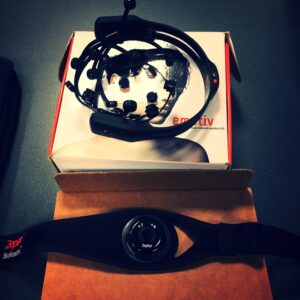User testing issues are at the heart of our UX Design business. This is why we pay particular attention to it in the UX lab' foundation. In this process we visited the Gobelins Ergo-Design lab, the school of image. Thanks to Nicolas Esposito (Head of research) for taking the time to present the place, the equipment and also for giving us feedback.
A modular space
Nicolas explains to us that this place is flexible, they use a screen to isolate the participants or to recreate a space “like at home”. For example to test video games there is a space with a sofa and a television to recreate the environment of use. Depending on the needs, the tables are moved and the decoration is adapted, because the atmosphere is important and the participants should not feel in a sterilized environment, on the contrary the environment must be welcoming and warm.
Eyetracking, the essential technology
They use solutions integrating eyetracking, both on computers with an oculometric bar, and for mobiles or objects with eyetracking glasses. This solution is one of the most widely used in user testing, it makes it possible to precisely identify the areas consulted by a user.
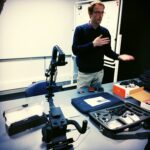
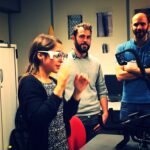
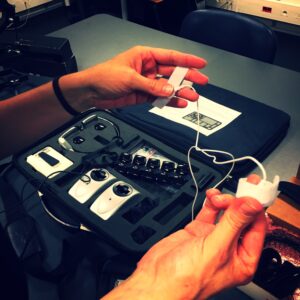
Measuring emotions
Very quickly we approach this subject which interests us a lot and which is at the heart of the user experience. What tools or methods can we use to measure the emotions of our users?
Physiological measurements
Nicolas explains to us that he sometimes uses tools to make physiological measurements (like the Zephyr belt for example), but also an (emotive) helmet to measure brain activity... There are two important elements to take into consideration with this type of measurement: 1/ the duration of the analyzes is long there is a lot of information to be used. 2 / these measures are suitable for activities provoking strong emotions!! For example to do tests on video games or for virtual reality. Suffice to say that it is not suitable for websites, mobile applications or business applications, the results on this type of product are often flat, with few variations.
facial expressions
And what about software that uses the method FACS (Facial Action Coding System) by Paul Ekman? Nicolas tells us that this type of measurement should be used with caution, some users express their emotions very well and others do not, so the results can be distorted! As we can see in this example “The Affdex API and User Testing” Pauline (UX Scientist at UX Republic) is testing the tool and she has to exaggerate her emotions a bit to vary the curve of emotions...
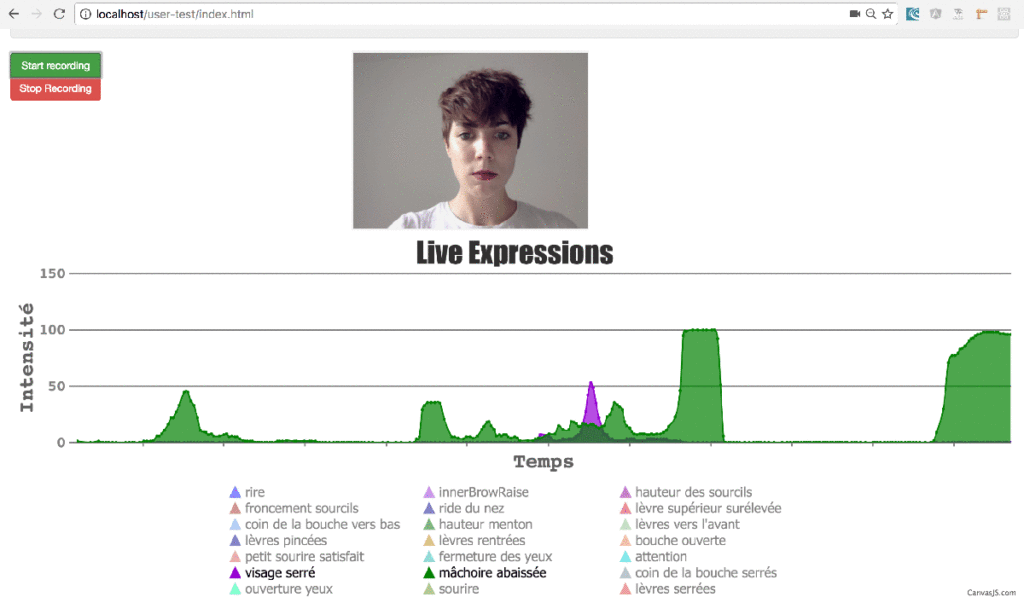
The advantage of these solutions is that the user cannot influence the results, and the measurement is said to be “objective”. On the other hand, the analysis time is longer than for eye-tracking, the quality of the recruitment of the user panel is more demanding (Will the participants be expressive enough?). Taking into consideration all these advantages and disadvantages, I think that this solution is suitable for very specific projects, where emotional involvement has an essential role.
The emotional measurement scales
Finally wouldn't it be better to directly ask the user for their emotional feelings? For this, various tools are available to us, such as PrEmo, The Geneva Wheel (Geneva Emotion Wheel) or even SAM (Self-Assessment Manikin). The advantage of these solutions is that we can adapt them according to the cognitive profile of the users. What must be remembered is that the ideal is to combine several tools and that they must be adapted to the products but also to the profile of the tester.
One-way glass or not?
From what we have observed at the Laboratoire des Lutins and that of the Gobelins is that the one-way glass is preferred, it is more comfortable for the observer and the customer. But what about the participant? After all, he must be the most comfortable to feel free to give us all the comments he wants. By asking UX designers for their feelings and the observations they have made, there is not one preferred solution over the other. Some say users immediately pick up one-way glass and there's a kind of mistrust ("I feel watched") when eventually the camera will be there anyway to keep track of those tests. And others observe that yes the user sees the one-way window but that he forgets it quite quickly.
Thanks again to Nicolas Esposito for taking the time to welcome us and share his experience with us.
Estelle Garcet, Master UX-Evangelist @EstelleGarcet – UX Lab Foundation @UXRepublic
ACCESSIBLE UX/UI DESIGN # Paris
SMILE Paris
163 quay of Doctor Dervaux 92600 Asnières-sur-Seine
AWARENESS OF DIGITAL ECO-DESIGN # Belgium
UX-REPUBLIC Belgium
12 avenue de Broqueville - 1150 Woluwe-Saint-Pierre
STORYTELLING: THE ART OF CONVINCING # Paris
SMILE Paris
163 quay of Doctor Dervaux 92600 Asnières-sur-Seine
UX/UI ECO-DESIGN # Paris
SMILE Paris
163 quay of Doctor Dervaux 92600 Asnières-sur-Seine
DESIGN THINKING: CREATING INNOVATION # Belgium
UX-REPUBLIC Belgium
12 avenue de Broqueville - 1150 Woluwe-Saint-Pierre
MANAGING AND MEASURING UX # Paris
SMILE Paris
163 quay of Doctor Dervaux 92600 Asnières-sur-Seine
DESIGN SPRINT: INITIATION & FACILITATION # Paris
SMILE Paris
163 quay of Doctor Dervaux 92600 Asnières-sur-Seine
UX-DESIGN: THE FUNDAMENTALS # Belgium
UX-REPUBLIC Belgium
12 avenue de Broqueville - 1150 Woluwe-Saint-Pierre
